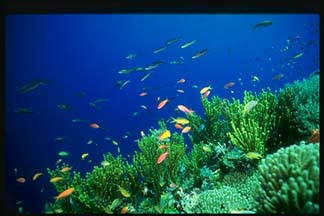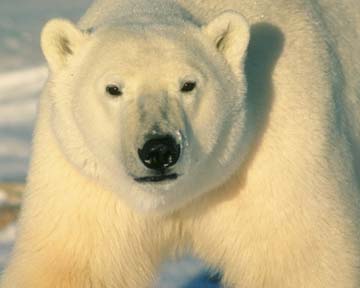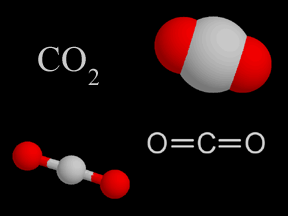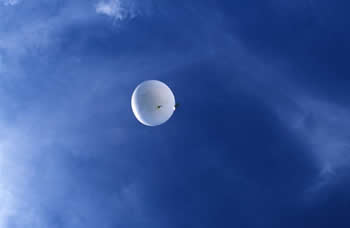This animation show where and when photosynthesis happens around the world as the seasons come and go. The land in the Northern Hemisphere gets greener each spring and summer, an indication of high rates of photosynthesis, and yellow during autumn as most plants become dormant and the amount of photosynthesis decreases. In tropical rainforest areas, plants live and photosynthesize all year long.
SeaWiFS Project
The Earth's Biosphere
The biosphere is all life on our planet. This includes all the things that are living as well as the remains of those that have died but have not yet decomposed. The biosphere includes life on land and in the oceans - multitudes of plants, animals, fungi, protists, and bacteria.
Have you heard the expression “carbon-based life forms”? The living things on our planet are called carbon-based because they are made of molecules that are chiefly chains of carbon atoms. These carbon chains really add up when you consider the total amount of life on the planet, as scientists do as they make models of the Earth system. Add it all up and the life on our planet contains approximately 1900 gigatons of carbon (that’s heavier than 116 billion school buses.)
The biosphere has a great impact on the non-living parts of the Earth, especially on climate. The impact on climate is mainly due to the connection between the biosphere and the atmosphere. Processes such as photosynthesis and respiration naturally affect the concentrations of gases such as oxygen and carbon dioxide in the atmosphere. Microbes in soils can add nitrous oxide gas to the atmosphere. As humans burn components of the biosphere such as fossil fuels, forests, and fields, greenhouse gases such as carbon dioxide and nitrous oxide are released into the atmosphere.
Russian scientist Vladimir Vernadsky was the first to use the term biosphere to refer to the living component of the Earth in his 1926 book, entitled simply “The Biosphere”.
Last modified May 7, 2007 by Lisa Gardiner.
You might also be interested in:

Though not the largest kingdom, with a mere 300,000 species catalogued, many might argue that the Kingdom Plantae just may be the most important group of living organisms. In the process known as "photosynthesis",
...more
Members of the Kingdom Protista are the simplest of the eukaryotes. Protistans are an interesting assemblage of organisms classified for what they are not. Protistans lack characteristics shared by plants,
...more
Eubacteria, also know as “true bacteria”, are microscopic organisms that have prokaryotic cells. Because of their prokaryotic cells, they have a rigid cell wall but no mitochondria or other large organelles,
...more
Photosynthesis is the name of the process by which autotrophs (self-feeders) convert water, carbon dioxide, and solar energy into sugars and oxygen. It is a complex chemical process by which plants and
...more
Respiration is the name of the general process by which living organisms convert sugars and oxygen into biochemical energy. The process occurs in all organisms, including animals, plants, fungi, and bacteria
...more
Carbon dioxide is a colorless and non-flammable gas at normal temperature and pressure. Although much less abundant than nitrogen and oxygen in Earth's atmosphere, carbon dioxide is an important constituent
...more
Look up into the sky and you look through millions of air molecules, eighty percent of which are nitrogen molecules, two atoms of nitrogen bonded together. Nitrogen is found all over the planet, not just
...more














